Building a fence gate is crucial to any fencing project, offering functionality and aesthetic appeal. While it may seem smaller than installing the full fence, the gate provides security, privacy, and easy access to your property. If you’re wondering how to build a fence gate, the process involves careful material selection, whether you choose wood for its timeless charm, metal for its strength, or vinyl for its low-maintenance benefits. Understanding each material’s specific gate installation techniques is essential to ensure durability and proper alignment. For those considering their budget, knowing the fence cost upfront, including the gate, is key to planning the project. At Ace Fence Company Austin, we specialize in helping homeowners install their fences and guide them through creating the perfect gate to match their property’s style and needs.
Calling all homeowners! Find out why mastering fence gate construction is essential for your property. https://t.co/Jza6kKFjUZ #homeimprovement #DIY #fence #residentialfence #fencecompany pic.twitter.com/gFkAqvsDux
— Ace Fence Company Austin (@AceFenceAustin) April 30, 2024
Why build a fence gate yourself?
Building a fence gate yourself has several key benefits. First, it increases property security, ensuring only authorized people can access your space. Second, it enhances privacy by creating a barrier that shields your property from outside views.
Additionally, this project allows you to add aesthetic value to your home, giving you the freedom to select designs and materials that perfectly complement your property’s style. Moreover, personalizing your space is easier when you take the DIY route, as you can customize the size, design, and materials to suit your specific needs and preferences. This approach results in a functional and visually appealing addition to your fence and instills a sense of personal satisfaction and accomplishment.
Increases property security
Building your fence gate significantly bolsters your property’s security. It is a robust barrier, effectively controlling who can enter and leave, ensuring that your home remains a secure sanctuary.
Enhances privacy
A DIY fence gate adds an essential layer of privacy to your living space. It acts as a shield, protecting your property from unwanted attention and allowing you and your loved ones to enjoy your outdoor areas in peace.
Adds aesthetic value
Crafting a fence gate yourself provides a unique opportunity to enhance the visual appeal of your home. Choosing materials and designs that match your home’s exterior can boost your property’s overall charm and curb appeal.
Next is: Top 5 Best Weatherproof Paint for Fence in Austin
Personalizes your space
Taking on the project of building a fence gate allows you to personalize your space entirely. Customizing the design, dimensions, and materials according to your preferences ensures that the gate serves its practical purpose and reflects your individual style, making your property distinctively yours.
Essential skills for building a fence gate
Mastering a few basic skills is indispensable for building a fence gate. Measuring accurately is key to ensuring the gate perfectly aligns with its intended space. Cutting wood or metal precisely is vital for achieving clean, snug fits between components.
Proficiency with essential tools, such as the hammer, saw, and drill, is crucial for correctly assembling parts. Lastly, a good grasp of basic construction and assembly techniques lays the foundation for constructing a gate that is not only sturdy but also visually appealing. These core skills streamline the building process and guarantee that the final gate is both functional and enhances the overall look of your property.
Measuring accurately
Accurate measurement is paramount when constructing a fence gate. It ensures all parts align correctly, eliminating potential gaps or misalignments that could affect the gate’s function and aesthetic.
Cutting wood or metal precisely
Precision in cutting wood or metal is essential for a smooth assembly process. Clean and straight cuts are crucial for the gate’s structural integrity and visual appeal, making precise cutting an essential skill in gate construction.
Using tools: hammer, saw, drill.
Proficiency with tools such as the hammer, saw, and drill is indispensable for building a fence gate. These tools are the backbone of the construction process, enabling efficient assembly and a polished finish.
Basic construction and assembly techniques
A solid understanding of basic construction and assembly techniques is crucial for crafting a durable and functional fence gate. Knowing how to join components securely ensures the gate’s longevity and reliability, making these techniques fundamental to successful gate construction.
Materials needed for a fence gate
Selecting the suitable materials is a pivotal step in constructing a fence gate that is both functional and visually appealing. The decision between wood or metal hinges on the desired aesthetic and the level of durability sought. Wood options, such as Cedar, Redwood, and Pressure-treated Pine, offer natural beauty and adaptability.
Metal options, including Aluminum, Steel, and Wrought Iron, provide unmatched strength and longevity. Essential hardware like hinges and screws are crucial for installation, with a variety of types available to accommodate different gate styles and weights. Hinge types—Strap, T-hinges, and Butt hinges—alongside screw types—Wood screws and Metal screws—ensure a secure and sturdy assembly.
Adding a latch or lock introduces an additional layer of security, with choices ranging from simple Bolt latches to more complex Keyed locks and Combination locks. Carefully selecting the appropriate materials and hardware is essential for crafting a fence gate that fulfills your security, privacy, and aesthetic requirements.
Choice of wood or metal
Selecting between wood and metal is a pivotal decision that influences your gate’s aesthetic appeal and durability. Wood offers traditional warmth, while metal offers unmatched strength and resilience.
Types of wood: Cedar, Redwood, Pressure-treated Pine
Wood varieties such as Cedar, Redwood, and Pressure-treated Pine cater to different preferences. Cedar and Redwood are prized for their natural beauty and resistance, whereas Pressure-treated Pine is valued for its affordability and robustness.
Types of metal: Aluminum, Steel, Wrought Iron
For those leaning towards metal, choices include Aluminum for its lightweight and rust resistance, Steel for superior strength, and Wrought Iron for a classic, ornamental look with durability.
Hinges and screws for installation
Hinges and screws play a critical role in gate installation, ensuring stability and longevity. The right choice supports the gate’s weight and complements its material.
Hinge types: Strap, T-hinges, Butt hinges
Different hinge types—Strap, T-hinges, and Butt hinges—serve various aesthetic and functional purposes. Strap hinges add a rustic touch, T-hinges support heavier gates, and Butt hinges are ideal for a sleek, flush fit.
Screw types: Wood screws, Metal screws
Screw types are chosen based on the gate material—Wood screws for wooden gates and Metal screws for metal gates, ensuring a secure and lasting assembly.
Latch or lock for security
Incorporating a latch or lock is essential for enhancing your gate’s security. This component is crucial for preventing unauthorized entry and safeguarding your premises.
Latch types: Bolt latch, Ring latch, Thumb latch
Latch types, including Bolt, Ring, and Thumb latches, offer different security levels and operational ease, allowing customization based on security requirements and personal preference.
Lock types: Keyed locks, Combination locks
For added security, lock types like Keyed and Combination locks provide robust access control, with options to suit various needs for convenience and security.
Steps to build a wooden fence gate
Constructing a wooden fence gate involves carefully planned steps to ensure functionality and enhance your property’s aesthetic. The journey starts with planning and design, where determining the size and style of the gate is crucial for it to complement your fence and overall property look. Selecting the suitable materials is next, with choices such as Cedar, Redwood, and Pressure-treated Pine offering varying benefits in aesthetics and longevity.
Measuring the gate opening accurately guarantees that the gate will fit perfectly. Cutting the wood to size and assembling the gate frame are critical steps that require precision and careful attention. Laying out the frame pieces and securing the corners with screws or brackets form the gate’s basic structure.
The concluding steps involve attaching the gate to the fence using hinges and installing a latch or lock to ensure security. Each step is essential in crafting a durable, reliable, and visually appealing wooden fence gate that will boost your property’s security and curb appeal.
Planning and design
Planning and design set the stage, guiding the overall vision for your gate. This initial phase is critical for aligning the gate’s functionality with your property’s aesthetic.
Determine the size and style
Determining the size and style is crucial and ensuring the gate fits properly and contributes positively to your property’s visual appeal.

Choose the right materials
Choosing suitable materials is essential for the gate’s longevity and aesthetic. Materials like Cedar, Redwood, and Pressure-treated Pine offer unique benefits in durability and style.
Measure the gate opening
Measuring the gate opening with precision is crucial for a seamless fit. Accurate measurements prevent installation issues and ensure smooth operation.
Cut the wood to size
Cutting the wood to size demands accuracy, as it lays the foundation for a structurally sound and visually pleasing gate.
Assemble the gate frame
Assembling the gate frame brings the project to life, connecting the cut pieces to the gate’s foundational structure.
Lay out the frame pieces
Laying out the frame pieces according to your design helps visualize the final look and allows for adjustments before securing.
Secure the corners with screws or brackets
Securing the corners with screws or brackets is pivotal for the gate’s stability and durability, ensuring it maintains its shape and functionality over time.
Attach the gate to the fence using hinges
Attaching the gate to the fence using hinges is a critical step, enabling the gate to open and close smoothly. The choice of hinges is crucial for accommodating the gate’s weight and size.
Install the latch or lock
The final step is to install the latch or lock, which enhances the gate’s security. This addition is vital for safeguarding your property and providing peace of mind.
Maintaining your fence gate
Proper maintenance is crucial for ensuring your fence gate functions effectively and retains its aesthetic appeal over the years. Regular inspection for wear and damage is essential to catch and address any issues early on. Repainting or staining every 2-3 years protects the gate from the elements and keeps it looking fresh and vibrant.
Furthermore, lubricating hinges and locks annually is critical to smooth operation and prevent rust. Adhering to these maintenance practices helps prolong the life of your fence gate, ensuring it remains a secure and attractive feature of your property.
Regular inspection for wear and damage
Conducting regular inspections for wear and damage is crucial. This proactive measure allows for the early detection and repair of any issues, safeguarding the gate’s integrity and operational functionality.
Repainting or staining every 2-3 years
Repainting or staining your gate every 2-3 years is critical to its upkeep. This enhances its appearance and provides a protective layer against the elements, extending its life.
Lubricating hinges and locks annually
Annual lubrication of hinges and locks is essential for smooth operation. This simple but vital maintenance step prevents rust and ensures the longevity of these moving parts.

Benefits of DIY fence gate building
Embarking on a DIY fence gate project offers numerous advantages, chief among them being cost savings on labor. By taking on the building process yourself, you primarily invest in materials, significantly reducing overall expenses. The project also instills a profound sense of personal satisfaction and accomplishment as your efforts materialize into a functional and aesthetic addition to your home.
Moreover, DIY gate building allows for unparalleled customization to fit personal taste and property needs, ensuring the result perfectly complements your home’s exterior. Lastly, undertaking this project equips you with a valuable skillset for future home improvement projects, enriching your practical abilities and boosting your confidence in tackling similar tasks.
Cost savings on labor
One of the standout advantages of DIY fence gate building is the cost savings on labor. By taking on the project yourself, the only expenses incurred are for materials, significantly lowering the total cost.
Personal satisfaction and accomplishment
The satisfaction and accomplishment of completing a DIY fence gate cannot be overstated. This achievement fosters a sense of pride and confidence in one’s abilities, enhancing the connection to your home.
Customization to fit personal taste and property needs
DIY projects offer unparalleled customization to fit personal tastes and property needs. You have complete control over every design aspect, from materials to style, ensuring the finished gate aligns perfectly with your vision.
Learning a valuable skillset
Learning a valuable skillset is a significant benefit of building your fence gate. This practical experience equips you with the knowledge and confidence to tackle future home improvement projects, expanding your DIY capabilities.
Frequently Asked Questions
How does building a fence gate enhance home security?
Constructing a robust fence gate fortifies a home’s perimeter, deterring unauthorized access and enhancing privacy. Homeowners gain peace of mind knowing their property is more secure against potential intruders.
What materials are recommended for building a durable fence gate?
For durability, treated wood, vinyl, or metal are recommended. Treated wood resists rot and pests, vinyl offers longevity with minimal maintenance, and metal provides strength and security.
Can building a fence gate increase a property's value?
Yes, adding a well-constructed fence gate can enhance curb appeal and security, making the property more attractive to potential buyers. This improvement can lead to an increase in the property’s market value.
What basic skills are required to build a fence gate?
Homeowners need basic carpentry skills, including measuring, cutting, and assembling. Familiarity with tools like saws, drills, and hammers is also essential. Patience and precision in following steps ensure a successful build.


